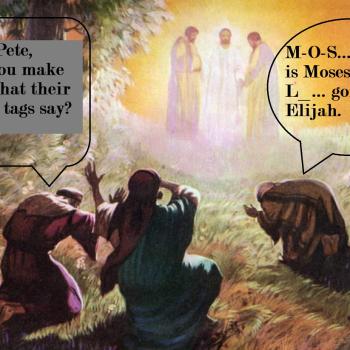I am delighted to have been given the opportunity to review Richard Carrier’s latest book, Proving History: Bayes’s Theorem and the Quest for the Historical Jesus
. I am grateful to Prometheus Books for sending me a free review copy.
Carrier emphasizes from the outset that this is the first of two books, the second of which will focus on the evidence for there having been a historical figure of Jesus. In fact, quite a bit of attention to both the figure of Jesus and the methods used by historians investigating him appears already in this first book. And as a result, by the time I had finished reading, I felt like I had already read two very different books. One of them is lucid, focused, methodologically rigorous, and full of powerful insights. The other reads like a case study in what happens when someone ignores their own sound methodological advice in practice when turning their attention to the figure of Jesus, an exercise which has led even some of the brightest minds in history to write some absolute nonsense, and many more to write things that were merely unpersuasive. I have read many other books where the same criticism could be made that I will here make of Carrier: the methodology is brilliant but the application is problematic.
This illustrates what is perhaps the most important point about the book and any evaluation of it. The application of Bayes’ Theorem to history is simply a matter of ensuring that strict formal logic is followed in historical reasoning. It does not turn history into mathematics, but nor does it guarantee that those who purport to use it will always manage to adequately assess their own blind spots, shortcomings, and clutching at straws in an attempt to reach a desired conclusion. Human assessment of probabilities is still involved, and the formula of Bayes’ Theorem cannot prevent one from misconstruing the likelihood of one’s own view or the unlikelihood of another’s and thus getting a flawed result. Only Bayes’ Theorem and a good deal of critical introspection and openness to criticism is likely to accomplish that. Or as they say in computing, “garbage in, garbage out”: if the probabilities entered are problematic, so too will the conclusion be.
However, Carrier makes a strong case that Bayesian reasoning can help expose when this is taking place. If so, then I fully expect that some of the claims Carrier makes in the present book will be revisited, and different conclusions drawn, when he writes his second volume. There is, however, an important point Carrier makes about Bayesian analysis in history requiring a wide-ranging knowledge of relevant language(s), historical texts, cultural and social data about time periods, and other such relevant background information, without which calculations will again be flawed. Whether Carrier is sufficiently acquainted with Jewish history and literature from this period to allow him to use Bayesian reasoning persuasively on his chosen subject matter is another important question which is bound to come up in his second volume, if the hints of his reasoning in this first one are any indication.
But let me now turn to viewing the brilliant book within the book, the one which makes important and insightful methodological points, and then return to flesh out my criticisms of the application of those methods (or failure to apply them in the manner Carrier himself says they ought to be) to the historical figure of Jesus.
For many historians and others in the humanities, the idea that one can express what we do in a formula may seem not merely wrong but even offensive. Carrier does an excellent job of clarifying what Bayes’ Theorem is and why such objections are inappropriate. While the letters and symbols can seem daunting at first, particularly to us humanities types, Carrier offers a “translation” into plain everyday English at more than one point in the book, including in an appendix which breaks the reasoning process of Bayes’ Theorem into a flow chart articulated in simple and clear English.
The key point of using the theorem, as I understand it, is to emphasize the appropriate logic to use in assessing the likelihood that one’s theory about a historical matter is correct. One of the most important points is the following: historians need not merely to look for a fit between their theory and the evidence, but to also consider the fit between that evidence and other competing scenarios and explanations. The historian using Bayesian reasoning will ask what the likelihood is of the evidence being what it is if their theory is correct, what the likelihood is if their theory is incorrect, what the likelihood is if an opposing theory is correct, and so on. This is to be done taking account of relevant background information as providing the framework within which historical questions and assessment of probabilities need to be answered.
In assigning a specific percentage of probability, it may be true that there is no way to say that the odds against evidence X arising without event Y having caused that evidence to exist are precisely 7 to 1. But in assigning a number or range of numbers to our estimation of probabilities, we are not being less precise than we already are. All probabilities that historians currently use have numbers hidden behind them, as Carrier emphasizes. And so it is useful to be forced to articulate more clearly whether we think that the likelihood is closer to 70% or closer to 90% – and to assess whether, if we are unsure which, it makes what we thought was a sound conclusion a much less certain one.
I don’t think there is any disputing that approaching history in this way may allow it to be more scientific in its approach. I sincerely hope that Carrier’s points about method will get some serious discussion, and that the shortcomings in his own application of the method will not lead to the methodological points themselves being ignored.
It may be that very often competing theories may do equal justice to the evidence, since often our evidence in historical research is piecemeal and dependent on what texts and artifacts just happen to have resisted the destructive effects of time’s passage to reach us. There may be multiple ways to fill in gaps. But even acknowledging this will lead to more fruitful discussions, since often the ways we fill in gaps in our knowledge reflect assumptions about the historical background of our question, or ideological convictions we hold, and bringing these into the foreground as part of the reasoning process more frequently than tends to be the case has the potential to make our scholarly conversations more productive.
In his introduction, explaining the rationale for his two-volume endeavor, Carrier says a lot about the quest for the historical Jesus, and about mythicism, that is right on target, although not all of it is. Carrier notes the problem of historians drawing such diverse conclusions about the historical figure of Jesus, and suggests that the diversity even among those working with the same sources and the same tools of historical criticism indicates that the methods of investigation are fundamentally flawed. This conclusion is not entirely fair, since the differences may result from (1) different ideological stances, (2) misuse of or failure to apply historical criteria and methods, and (3) the different ways that authentic material may be interpreted and configured. Indeed, his own discussion of methods and specific details indicates that the methods can be perfectly fine and yet not lead inevitably to well-reasoned, persuasive conclusions. But that said, no one denies that the methods used in historical investigation of Jesus but in positivistic historical investigation more generally need to be re-examined. And the diversity of conclusions drawn about Jesus have exposed problems not only with the criteria of authenticity, but the attempt to treat the Jesus tradition atomistically, as though individual sayings can be evaluated while ignoring the gist of what our earliest sources have to say. To do so is seriously problematic, as Dale Allison in particular has recently pointed out.
But let me accentuate the positive once again. Carrier writes early in his second chapter, “To laypeople who ask me what history to trust, I always offer three basic rules: (1) Don’t believe everything you read; (2) always ask for the primary sources of a claim you find incredible; and (3) beware of scholars who make amazing claims about history but who are not experts in the period, or aren’t even experienced historians at all. That three-step guideline provides a basic inoculation against most bad history” (p.17). This is sound advice, and Carrier seems at times to be aware that it blows most if not all current treatments of Jesus by mythicists out of the water.
Carrier proceeds to list twelve key axioms of historical method, followed by twelve rules to be followed. I will not list all the points, but will focus on those most directly relevant to the question of whether there was a historical Jesus. On the subject of seeking consensus among historians and scholars, Carrier writes, “This process cannot be bypassed, as specialists in a field are the most qualified to assess an argument in that field, so if they cannot be persuaded, no one should be (unless their resistance can be proven – not merely assumed – to have other motives than truth-seeking). Conversely, if they are persuaded, everyone else has a very compelling reason to agree (unless, again, their acceptance can be proven – not merely assumed – to have other motives than truth-seeking). This is the social function and purpose of having such experts in the first place” (p.21). Carrier even articulates as a separate axiom that “an effective consensus of qualified experts constitutes meeting an initial burden of evidence” because “it is far more unlikely that an incorrect argument would persuade a hundred experts than that it would persuade only one; and it’s far more unlikely that it would persuade any expert than that it would persuade even a hundred amateurs” (p.29).
If the internet mythicists of today were to take this advice to heart, they might work on trying to actually publish scholarly works in appropriate venues, instead of complaining about their being dismissed in a manner that Carrier rightly says is appropriate when people without relevant expertise try to bypass peer review and scholarly discussion and promote their ideas directly to a public ill prepared to assess them. Even if the majority of scholars might still disagree with them if they did this, that is the risk those who propose new theories take, and at least they would not remain a pseudoscholarly group seeking to bypass the academy and appeal directly to the masses with arguments that do not pass muster as scholarship, but would have begun to approach the matter in a scholarly fashion.
There are many other points which Carrier makes which likewise sound the death-knell of mythicism in its currently-popular forms (for instance, his point on p.39 about not relying on pre-1950 scholarship and focusing on work more recent than 1970), and Carrier’s genuinely scholarly stance on these matters, given his sympathy towards mythicism, is incredibly refreshing.
After the chapter on Bayes’ Theorem, the next chapter uses that theorem to assess the validity of historical methods, and the chapter after that focuses on the criteria of authenticity articulated in the quest for the historical Jesus. Carrier joins with other scholars and historians in criticizing the criteria. But Carrier sometimes agrees with scholarly criticisms of the criteria that ought to seem less impressive in light of his Bayesian analysis and the points he had already made in his book. For instance, the fact that we do not have a complete and comprehensive background against which to determine what would have been embarrassing to early Christians is by Carrier’s own statements irrelevant, since a Bayesian approach assesses probability based on the evidence we have. If new evidence comes to light, we change our analysis if necessary, but we ought to proceed based on the evidence we have, as Carrier acknowledged elsewhere in the book. And so I found myself puzzled as to why this point did not lead him to defend certain criteria against this irrelevant criticism.
His treatment of the criterion of embarrassment seemed particularly problematic in view of his use of a softer form of it elsewhere in the book. Indeed, in discussing a fictional ancient person in chapter 6, he finds it persuasive to argue in terms of “the absence of any likely or discernible reason for the story as we have it to have been made up (by the historian or his source)” (p.253). Yet in his treatment of the criterion of embarrassment – which focuses on things which are not merely indifferent to an author, and so unlikely to have been invented, but things which are even less likely to have been invented because they run counter to the author’s or his community’s aims – Carrier claims that anything included in an early Christian work must have been worth including and therefore could not have been embarrassing. But by this token, any detail in any text seemed worth including to its author, and could therefore be deemed suspect. And so Carrier needs to apply to the early Christian sources the same principles and standards of evaluation he himself recommends.
I could make similar point about other aspects of Carrier’s treatment of the criteria, but this example seems to most glaringly illustrate the disconnect between his affirmed methodological principles and what he actually does with the historical quest for Jesus. And so we see that, in spite of his working with Bayes’ Theorem, this does not in practice prevent Carrier from falling back into the sorts of apologetic arguments that have been the bane of attempts to study Jesus in any sort of dispassionate, scientifically rigorous kind of way. But perhaps it does show that Carrier is right when he suggests that Bayesian analysis can be helpful in drawing attention to those places where one’s argument is problematic. Carrier’s own arguments in places are found wanting by posing the questions and demanding the logically consistent treatment that a Bayesian approach calls for.
If in his second volume, Carrier actually rigorously applies to the early Christian sources the methods he outlined in this book, then it will in all likelihood be a fantastic volume. But if he is faithful to his Bayesian logic, it will not be a book that supports mythicism, the idea that there was no historical Jesus at all behind the later mythologized and legendary portraits of him. Either way, Carrier will also need to get to grips with a wider array of relevant textual sources about ancient Judaism. In some instances, Carrier works with English translations, seemingly unaware of possible dogmatic influences that may have influenced the translation. He even continues to make reference to the long-discredited idea that Jesus was thought of as “God” or “a god” by his earliest followers – as though this were not precisely the sort of place where a critical scholar, unencumbered by faith commitments, ought to see claims to the contrary for what they are, namely the anachronistic influence of dogmatic credal statements of later orthodoxy on an earlier period where they are not applicable and do not fit the evidence.
He also continues to discuss whether “messiahs” (i.e. anointed figures like kings and high priests) could die – something that no one to my knowledge has ever disputed – rather than focusing on the smaller set (again, as his Bayesian approach requires) of the specific type of anointed one that the earliest Christians claimed, namely a Davidic anointed one, the figure expected to restore and rule the kingdom of his forefather David. There is no text from this period which suggests that the individual of Davidic descent who was expected to restore the dynasty of David to the throne was also expected to fail before achieving that by getting executed by foreign rulers. The only way to argue that this was more likely invented is to say that anything in a text could be invented – which is true, but it is not a valid piece of Bayesian reasoning. This is true of all texts, in theory, and an “explanation” that can fit any evidence has little or no explanatory value in and of itself. The question is whether it is more likely that a group who followed a messianic claimant of the sort we know appeared in this period in history made sense of his failure by giving his execution of positive interpretation, or whether it is more likely that a group invented a purely fictional failed Davidic anointed one and set about trying to persuade their contemporaries to believe in him. To every scholar with a substantial background in early Christianity or ancient Judaism, the choice seems a no-brainer.
Carrier will likewise need to apply rigorous Bayesian analysis of likelihoods of the meanings mainstream scholars and mythicists give to the reference to “James the brother of the Lord” in Galatians. If one considers “brother of the Lord” to be distinct from “brother in the Lord” then the matter already seems fairly clear (see e.g. John 2:12). But if one considers the depiction of Jesus calling his disciples “brothers” (see e.g. Matthew 12:49) makes it possible that “brothers of the Lord” was a way of referring to them, then we must ask whether the term is more likely to have been used to differentiate James from Peter if this was the meaning. As Carrier emphasizes, in a Bayesian analysis, the question must be which is more likely given the evidence, and whether the same evidence would be as likely if an alternative explanation were the case. But time and again, when it comes to the matter of the historical Jesus and the evidence that there was such a figure, Carrier falls back on arguments that do not reflect the rigorous Bayesian logic he calls for historians to use.
This will be most glaring if Carrier fails to conclude in his second volume that it is far more likely that, when Paul wrote that Jesus was “born of a woman” (like all human beings) and “born under the Law” (i.e. Jewish) and “of David according to the flesh” and so on, he believed Jesus had been a human being who appeared in history. If Carrier’s method can take such relatively straightforward mundane statements, and claim that they more likely refer to things that transpired in a celestial realm, then Carrier will have showed that his method does nothing to add rigor to historical study – not necessarily because Bayesian reasoning is flawed, but at least because it will have become clear that even being a vigorous advocate for Bayesian reasoning will not prevent one from being illogical, when one has spent too much time using and listening to apologetic-style arguments of whatever sort.
But sticking to examples that come up in this volume, another place where Carrier fails to be true to his own principles and shows a glaring lack of familiarity with relevant scholarship is in his discussion of Jesus’ alleged connection with Nazareth. On the one hand, his use of Rene Salm’s self-published armchair opinions (p.142) is at variance with his emphasis on both the need for relevant expertise (Salm has no qualifications or experience relevant to either the archaeological or the linguistic matters on which he comments, and regularly gets things wrong), and the appropriateness of ignoring fringe claims with little probability of being correct when doing Bayesian calculations. Carrier’s own linguistic deficiencies become apparent when he treats Irenaeus’ account of the symbolic meaning given by Gnostics to words as indicative of the actual meaning of those words (p.142). While there is a legitimate line of investigation about the relationship between the various forms of Nazareth and terms allegedly associated with it (in particular Nazorean), without the relevant background in Semitic linguistics, the matter is not going to be given a plausible explanation, and because of his lack of background and expertise in this particular area, Carrier seems unable to discern when Salm is offering him bunk packaged to look to the non-expert eye like scholarship.
But perhaps most telling is when, with respect to Matthew 2:23 and the possibility of a connection with Nazareth deriving from prophecy, Carrier writes, “Unless Matthew was lying…” (p.144). Even a cursory familiarity with scholarship on Matthew would make one aware that Matthew almost certainly was lying – or if not, then had experienced a lapse of memory. The “prophecy” Matthew appeals to here is not found in any known Scripture. Moreover, most of the alleged connections between Scriptural texts and Nazareth (proposing connections with words like “branch” or the Nazirite vow) are linguistically tenuous, and in most cases they are mentioned in discussion of Matthew 2:23 precisely in an unpersuasive attempt to salvage Matthew from having lied or been mistaken, by proposing any possible connection with an actual text, however slim the link. Carrier’s willingness to accept Matthew’s claim about prophecy when there is no known text in view, but not Matthew’s mundane claims about things Jesus said and did even when they are unlikely to have been invented, shows an inconsistency. The problem is perhaps due to a lack of familiarity with the scholarly study of these texts, which is a vast field and a challenging one for an outside to try to become familiar with – that is true of most scholarly fields, many of which have not seen the voluminous output for which Biblical studies is renowned/notorious. But that is precisely why Carrier advised, here in his own book, that detailed familiarity with relevant background information and scholarship is crucial to assessing probabilities.
And so the next volume will provide a crucial test for all that is good (and some of it really is very helpful) in this first volume. If Carrier applies rigorous Bayesian logic to the matters mentioned above, and to other comparable cases, we will perhaps at long last be able to put this mythicist nonsense aside and focus where we ought, namely on seeing whether these methods can help sift out specious reasoning to lead to solid conclusions about the historical Jesus. If these rigorous logical methods don’t enable Carrier to see through where mythicist reasoning is illogical and faulty, then Carrier will not only fail to make a persuasive case for mythicism, but he will also demonstrate that his proposed methods do not actually correct for faulty reasoning or bias in the way that he hoped. Because ultimately, as was said above, Bayes’ Theorem only helps if the human beings who utilize it do so correctly, fairly and logically.
But while we wait for that second volume, it will be very valuable for scholars and historians to interact with Carrier’s current volume, with its proposed methods and its claims both persuasive and unpersuasive, and to provide feedback to Carrier himself. Carrier has a blog, where he posts on occasion about topics that he is working on. Among the offerings on his website is a Bayesian calculator which allows one to work through the logical structure of the theorem verbally rather than using symbolic notation. The more scholars interact with Carrier now, pointing out instances where a greater knowledge of relevant background material leads one more naturally to a different conclusion, or where he is not being true to his own stated principles and methods, the more likely it is that the second volume will actually offer something of benefit to the quest for the historical Jesus, assuming, that is, that Carrier is open to critical feedback from scholars working in this field, in the manner that he says that historians need to be.













